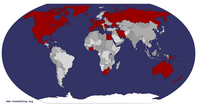Alaska 1962
June 15th 1962 -» July 6th 1962
Around the World 1963
July 24th 1963 -» August 18th 1963
South Pacific 1964
August 8th 1964 -» September 7th 1964
Panama Canal Cruise and More 1965
July 11th 1965 -» July 30th 1965
Africa 1968
July 29th 1968 -» September 7th 1968
South America 1969
August 2nd 1969 -» September 2nd 1969
Europe 1970
July 26th 1970 -» August 26th 1970
Iran and India 1971
July 29th 1971 -» August 27th 1971
British Isles and Scandinavia 1972
July 29th 1972 -» August 26th 1972
Eastern Europe 1975
July 18th 1975 -» August 14th 1975
South America 1976
July 25th 1976 -» August 20th 1976
Christmas in California 1984-1985
December 20th 1984 -» January 1st 1985
Coasting Along California Route 1 1987
June 24th 1987 -» July 1st 1987
Western North Carolina 2002
March 25th 2002 -» March 28th 2002
Japan 2005
March 18th 2005 -» March 25th 2005
Niagara Falls 2005
August 15th 2005 -» August 19th 2005
Western Caribbean Cruise 2006
August 19th 2006 -» August 27th 2006
Eastern Caribbean Cruise 2007
June 22nd 2007 -» June 30th 2007
Eastern Caribbean Cruise 2008
June 17th 2008 -» June 25th 2008
Bahamas Cruise 2010
March 21st 2010 -» March 28th 2010
Bermuda Cruise 2010
September 4th 2010 -» September 14th 2010
Southeastern Sojourn 2011
March 20th 2011 -» March 24th 2011
Central Europe 2011
September 24th 2011 -» October 5th 2011
Savannah Sojourn 2012
April 1st 2012 -» April 7th 2012
Italy 2012
September 26th 2012 -» February 18th 2013
Road Trip Through the Heartland
July 31st 2013 -» August 6th 2013
Spain 2013
September 27th 2013 -» October 7th 2013
Benelux 2014
September 13th 2014 -» October 5th 2014
France 2015
September 16th 2015 -» September 27th 2015
Western Caribbean Cruise 2016
March 3rd 2016 -» March 13th 2016
Baltic Cruise 2016
August 28th 2016 -» September 10th 2016
Southern Caribbean Cruise 2017
March 3rd 2017 -» April 2nd 2017
British Isles Cruise 2017
August 1st 2017 -» August 17th 2017
Poland 2018
September 12th 2018 -» September 24th 2018
Cuba Cruise 2018
October 21st 2018 -» October 28th 2018
Panama Canal Cruise 2019
March 1st 2019 -» March 17th 2019
Canadian Maritimes and Greenland Cruise 2019
August 18th 2019 -» September 4th 2019
Rhine River Cruise 2019
September 29th 2019 -» October 9th 2019
North Carolina's Outer Banks
October 4th 2021 -» October 8th 2021
Iceland 2022
May 28th 2022 -» June 5th 2022
Colorado 2022
July 15th 2022 -» July 20th 2022
Portugal and Spain 2022
October 11th 2022 -» October 24th 2022
Walt Disney World's 50th Anniversary
November 29th 2022 -» December 2nd 2022
Belgium & Netherlands Tulips Cruise 2023
April 22nd 2023 -» April 30th 2023
Alaska Cruise 2023
August 13th 2023 -» August 22nd 2023
Amsterdam to Budapest River Cruise 2024
April 27th 2024 -» May 12th 2024

















